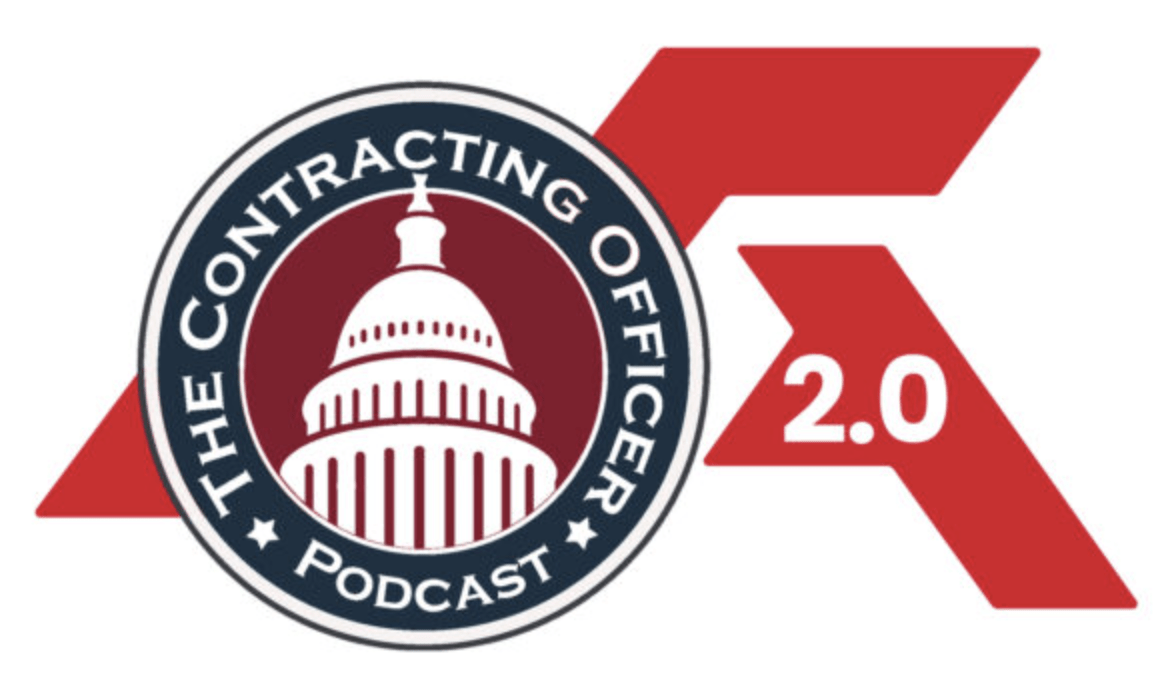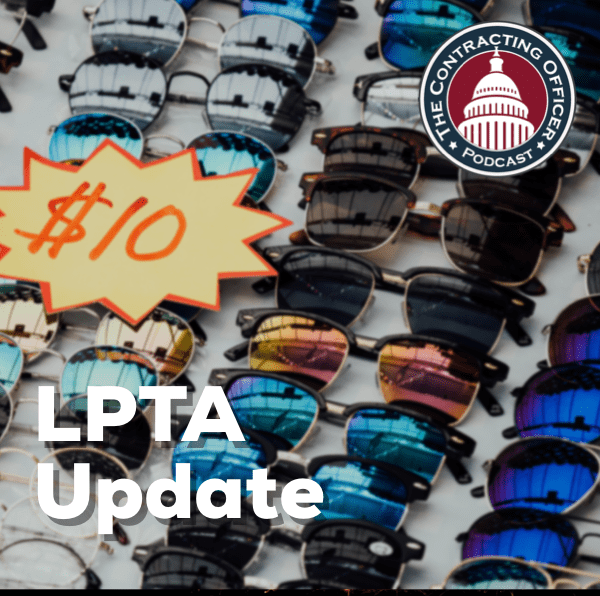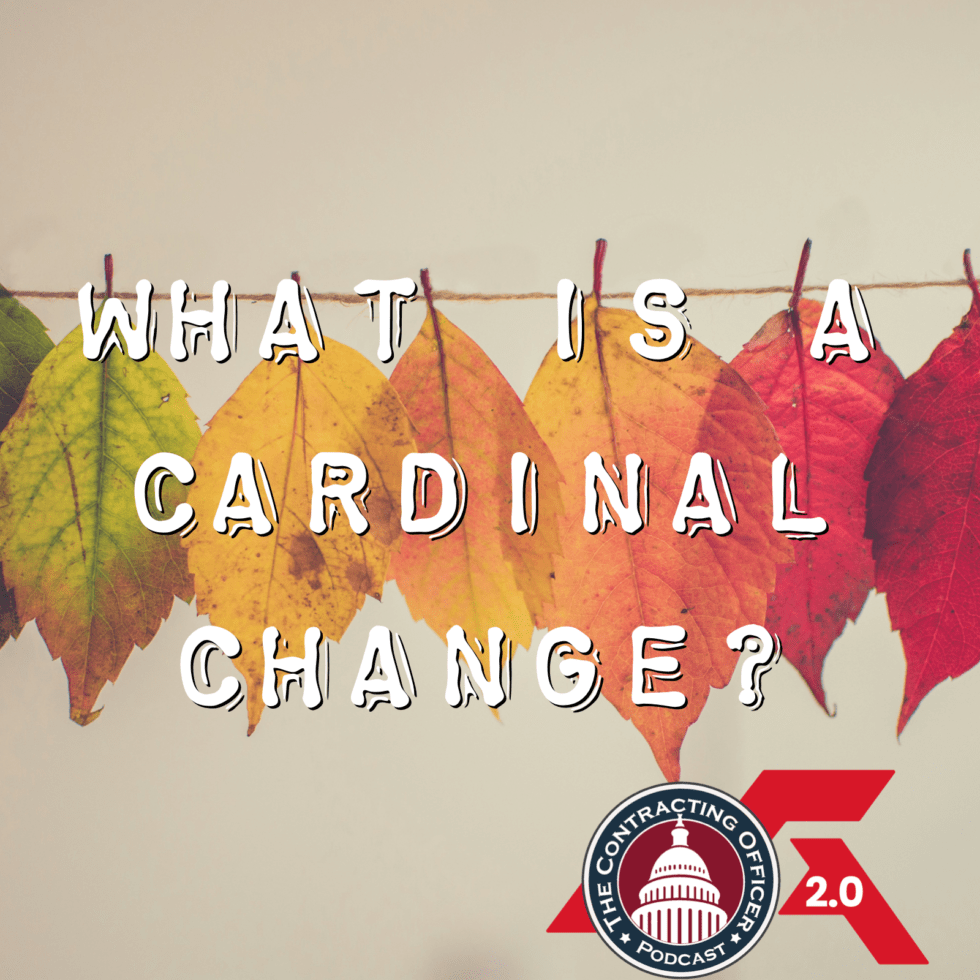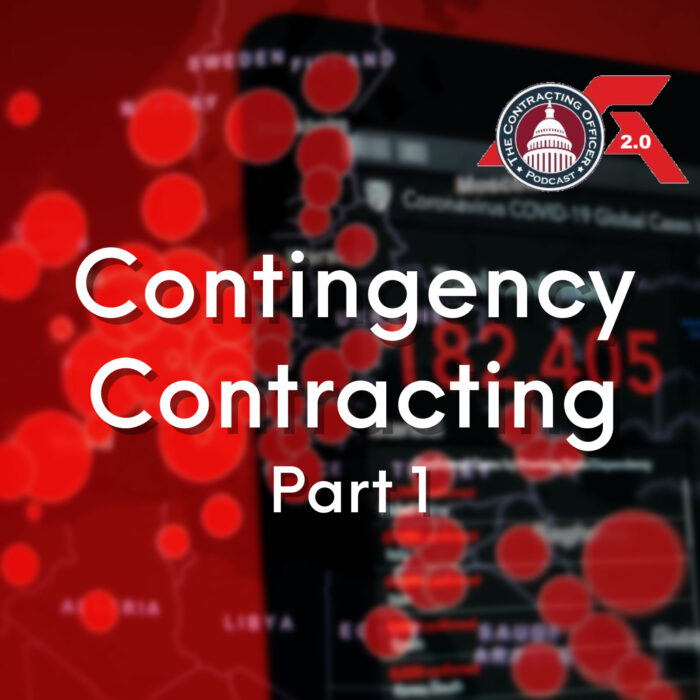An innovative training resource that provides Functional GovCon Fitness.
Learn GovCon from both sides – from former Contracting Officers. Enjoy your free trial today!
The Contracting Officer Podcast helps both government and industry better understand more about how the other side thinks. Our weekly podcast improves your Government Contracting skills constantly. Sound too good to be true? Tune in to our free trial playlist (available below) to see for yourself.


Trial Playlist
This exclusive bundle includes 10 expert-led podcast episodes, each focusing on a specific aspect of government contracting. From getting started with federal contracts to mastering the intricacies and keeping in compliance, this series is designed to give you the insider knowledge you need to succeed.

336 - LPTA Update
Lowest Price Technically Acceptable (LPTA) is an acquisition strategy that recently become controversial enough that acquisition regulations have been updated to somewhat limit its use.
Kevin and Paul provide an overview of the regulation updates and discuss how, like any acquisition strategy, LPTA can be a powerful tool if used appropriately and a disaster if misapplied.

449: What is Contract Severability?
In this episode, Kevin and Paul explain the difference between severable and non-severable service contracts. They outline what Severability is, why it matters, and how to navigate it in the context of the funding appropriations that drives the issues with “crossing” fiscal years.
Whether you award service contracts (from the government side) or are awarded service contracts (from the industry side), it’s important to understand this concept of Severability.
Thank you to one of our Podcast 2.0 subscribers, Jeanne Cassidy, for requesting we cover “Severability” in this episode. Neary 450 episodes in and Kevin and Paul still have a lot of topics to cover. They appreciate when they get to make episodes directly for our subscribers.

464: What is a Determination and Finding?
Some of those determinations require approval…or at least formal documentation of the reasoning behind the determination. In those cases, the government team, normally the contracting officer, uses the Determination and Finding (D&F) format. In the D&F, the Contracting Officer outlines the “determination” they made, as well as the “findings” that support that determination.
In this episode Kevin and Paul cover the why, what and how behind the “D&F”.
As a follow up: In episode 460 (with Desmond Culler) Kevin talked about buying commercial services in #GovCon. Buying commercial services is one of those areas where a D&F may be required….and in that episode he realized we had not created an episode about “what is a D&F”…so, as promised in that episode, here is it. ☺

471: What is an IGCE?
One way the government team can assess whether a price is reasonable is to build a formal estimate. This formal estimate is normally called an “Independent Government Cost Estimate” (or IGCE).
In this episode, Kevin and Paul explain the “what” and “why” behind the IGCE. Sometimes the regulations recommended the use of an IGCE. Sometimes the regulations require the use of an IGCE. They cover both scenarios in this episode.
This episode is for you if you’re wondering what drives the government to use IGCEs, and why they are often a big part of many government contract award processes.

479: Cardinal Change
However, not all changes are equal. In episode 478, we talked about the 3 levels of changes:
– Green light changes are unilateral
– Yellow light changes are negotiated
– Red light changes are not allowed
A Red light change is sometimes referred to as a “Cardinal Change”. In this episode, we explain what Cardinal Changes are, along with some steps on how to spot them, and why they are bad for both government and industry.

431 - What is Contingency Contracting?
One of the lesser known types of contracting is Contingency Contracting. This is contracting in an unknown or unstable and often unsafe environment. Contingency Contracting Officers award contracts and procure goods and services in response to disasters, as part of stability efforts in foreign nations, and/or in a war zone (for example). In other words, NOT a traditional business to government environment.
In this episode, Kevin is joined by Troy Small from the Skyway team. Troy is a retired US Marine Corps Contracting Officer. One of his many roles in contracting was as a Contingency Contracting Officer in Iraq. He knows this role from the ground level.
Troy helps Kevin outline what contingency contracting is – and how being a Contingency Contracting Officer is unique, and uniquely interesting, in many ways. We explain how Contingency Contracting Officers operate in a different environment, in a VUCA environment (more on that in the episode).
This episode will likely broaden your perspective on what contracting officers do, and how they do it, in a VUCA environment.

450: Types of Solicitation
As you can imagine, the contracting officer has lots of options on how to buy something…Kevin and Paul cover so many of them in 400+ podcast episodes. One of the elements in the process of deciding how to buy something is deciding which type of “solicitation” is appropriate, applicable, allowed, etc.
What type of solicitation would/should/could the Contracting Officer use? An RFQ, an RFP, an IFB, an oral RFP, or a combination?
In this episode, they outline the types of solicitations in government contracting and the why, how and what behind them.

466: Basis for Award
Here’s a Simplified Buying Process.
Step 1. Identify the problem
Step 2. Decide to buy something to solve the problem
Step 3. Decide how to differentiate between options (choose a Basis for Award)
Step 4. Get offers from sellers
Step 5. Pick an offer using the Basis for Award from Step 3.
While GovCon is nowhere near that simple, this process shows the importance of the Basis for Award. When awarding government contracts, especially through source selection, It’s critical for both government AND industry to clearly understand how the award decision will be made. That decision comes from the Basis for Award.
In episode 465, Kevin and Paul covered what “evaluation criteria” and “evaluation factors” are. In this episode, they dig into why these two elements are so important, and how they combine to become the “Basis for Award.” Without a clear understanding of Basis for Award, it is difficult to effectively and efficiently award contracts to meet the requirements we started with in Step 1.

473: Writing Requirements
The point of a government contract is not to award a contract.
The point of a government contract is to meet a need for a government customer. The official term for that “need” is the “requirement”. It can often be difficult to describe that need in terms of the problem the contract is solving…not the product the contract is delivering.
Cesar Lopez joins Kevin on this episode to help map out this concept of writing requirements. Cesar is the newest member of the Skyway team. He is a retired US Marine Corps Contracting Officer who has decades of experience across many of the GovCon topics we cover on our podcast.
Cesar shares his experience and his stories of how writing requirements well, or not so well, can be THE difference in whether the contract is awarded to deliver what the government customers wants….or some cases whether the contract is even awarded at all.

483: Fixed Price with EPA
The government buys many (or most) things using Firm Fixed Price (FFP) contracts. This contract type is a great option when the government clearly knows what it wants and the contractor knows how to deliver it (see episodes 320 and 473 about building those requirements). FFP is also the ideal option for buying commercial products and services (see episode 386 about using Commercial acquisition procedures).
But what if some part of a FFP contract is more volatile? What if FFP would be a great fit for a contract – except for that one item that has a much more volatile price. In that case, the contractor may not be willing, or able, to absorb the risk of performing the entire contract at a fixed price because that one variable drives so much cost – therefore, the risk that the contractor will lose money is too high.
Enter: the Firm Fixed Price contract with Economic Price Adjustment (the FFP EPA). This contract type allows for the government to adjust the price of one (or a few) particular elements that may drive cost throughout contract performance. The adjustment serves as a guardrail to keep that the one cost from overshadowing the cost of the entire contract.
In this episode, we dig into FAR 16.203 to outline the why, how and what behind the use FFP EPA.

